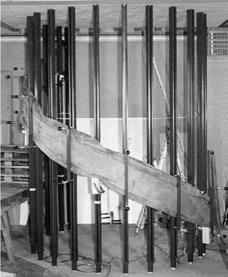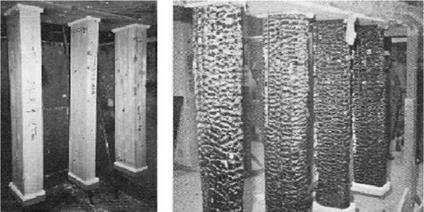In modern wood construction, not only girders are prefabricated by means of laminated wood technology, but also various other elements including stairs, windows, doors, whole attic storeys and walls. The motivation for using prefabrication technology has been described in the above section. Figure 8.21 shows the fabrication of a stair string where the laminated veneer lumber is formed around a gauge. The adhesive joint is then cured by means of a vacuum press under atmospheric pressure. The stair is assembled later as a cantilever stair, that is, it is fixed only at the top and at the bottom.
Often, prefabricated elements are composed not only of wood, but specific properties may be conferred to a material by including metals, plastics or fibers.
For example, the introduction ofan aluminum plate in an external door prevents the door from warping due to weathering. Furthermore, the aluminum plate represents an absolute barrier for different moisture conditions prevailing both inside and
|
Figure 8.21 Prefabrication of a staircase element (stair string) which is formed by a vacuum press (foil bag) around a gauge. |
outside the building. A third function of the metal plate is to improve the behavior of the door element in the case of fire. The insulation properties with regards to heat and sound play an important role in the case of wall elements and edges of windows. In contrast to mechanical joining techniques, using for example nails or screws, adhesive joints do not build up any heat or sound bridges. Sandwich elements consisting ofwood bonded to specific insulators allow the highest energy and sound protection standards to be met. It is even possible to construct a building without any heating system, even in a central European climate.
Engineered Wood Products Made from Strands, Fibers and Composites Engineered wood products are fabricated by pressing strands, laminated strands, fibers or short-board elements into panel elements, mostly using synthetic resins based on formaldehyde condensation products or polyurethanes or, more seldom, mineral binders. For this technology, woodcuts that may not be used as building material, or rapidly growing plantation wood species, are employed. The classification of these materials with regards to their load-bearing capacity has been standardized. For example, Dunky and Niemz [19] have provided an extensive discussion of the technology and the influencing factors, as well as an overview of the standards concerning wood and engineered wood products, including their testing.
Behavior of Wood in the Case of Fire The everyday experience that wood will burn may lead to an erroneous assessment of the safety of buildings made from wood. On the contrary, even if they do burn, solid and thick layers burn slowly and in a foreseeable manner. In contrast to steel girders — the strength behavior of which is not foreseeable in the case of fire (called ‘catastrophic failure’) — burning wood constructions do not bend without early warning. The thermal degradation of wood starts at around 150 °C, inducing the expulsion of flammable gases while simultaneously producing charcoal. Starting at this temperature, but critically between 300 and 400 °C, spontaneous ignition of these gases then occurs. The burning reaction, in being exothermic, causes a thermal feedback with regard to the surface to be produced, and this results in a sustaining flame. However, if the temperature rises further (i. e. above 500 °C), the ratio of charcoal production to gas expulsion shifts in favor of charcoal, which has a considerably lower thermal conductivity than wood; this in turn results in a limitation of the thermal feed-back mechanism. The burning process reaches a quasi-equilibrium that is disturbed as soon as further joints open, resulting in an enhanced burn-up speed. Consequently, the behavior of adhesive joints in the case of fire is of utmost importance for the suitability of gluelam as a structural material. Tests performed on beams of gluelam in a fire resistance test according to ISO 834-1975 have shown that, under the influence of extreme heat, adhesive joints do not fail earlier than the wood adherents they hold together (Figure 8.22). Indeed, even next to the fire zone there was no delamination of the wood layers. The shear strength of the adhesive joints within the noncarbonized part of the beam still corresponds to that of the intact parts [21, 23].
|
Figure 8.22 Gluelam beams before and after a fire test [20, 22]. |
8.4.11
Prospects of Wood Constructions
Within the scope of the COST project, two working groups of the European Cooperation in Science and Technology studied ‘Wood Adhesion’ and ‘Glued Wood Products’ [20, 22]. These State of the Art Reports not only present an extensive collection of material and references, but also provide recommendations for potential future research and development activities. As the saying goes, ‘the proof of the pudding is the eating’ and, as a final consequence it will be the end consumer who will decide whether products made from wood will be highly sought after, or not. And it is for the architects, designers, engineers and adhesive professionals to translate new ideas into highly sought-after, wood-based products.
 23 ноября, 2015
23 ноября, 2015  Pokraskin
Pokraskin 

 Опубликовано в рубрике
Опубликовано в рубрике 